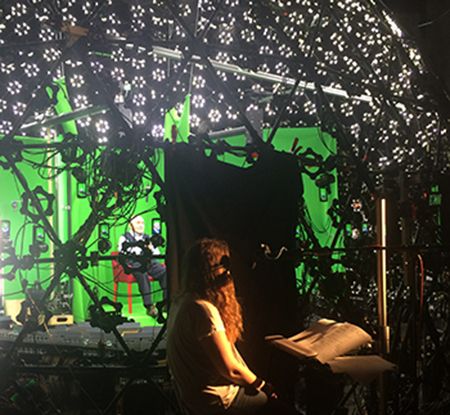When the Past and Future Intersect
As a writer fascinated by literary and political theory on history and memory, I watched students from Camino Nuevo High School interview Holocaust survivor Pinchas Gutter while I sat in awe witnessing the past and future intersect before my eyes.
Enthusiastic about the USC Shoah Foundation’s New Dimensions in Testimony, developed in concert with USC institute for Creative Technology, I was ecstatic at the prospect and privilege of engaging with this technology. I had no idea, however, that one afternoon of helping to build three-dimensional interactive testimony would prove to be an emotional and highly intimate experience.
Since my days as a freshman at Santa Monica High School studying ethics and tolerance in an introductory seminar led by now-principal (and Shoah Foundation Master Teacher) Renee Semik, I have immersed myself in the Visual History Archive’s resistance narratives. At the filming of the pilot for the New Dimensions in Testimony project, I felt the spirit of a young girl, myself, who once created a metal wire sculpture of two roses coming together, inspired by the first testimony I ever watched from a survivor named Rose. But this time, rather than listen to an interviewer craft his or her own questions as I sit patiently watching and listening behind my laptop screen, I am able to use my own my mind and my own voice to ask questions. I asked Pinchas questions that stemmed from my academic interest in religion, my love of music, and my desire to learn more about particular images and other fragments from his war experience that reoccur often in his mind.

Growing up in a musical home and now studying and singing with the USC Thornton Early Music Collegium Workshop, I listen daily to the lush polyphony of fifteenth century Gregorian chant. But, Pinchas’ story has colored this music with a cultural dichotomy, and I will forever remember and envision a young boy who wanted but was not allowed to listen.
I will remember a genocide survivor who overcame his personal encounters with anti-Semitism by devoting his life to helping others and by pursuing a career in music and becoming a Cantor in his synagogue. The daughter of a Cantor myself, I will always take with me Pinchas’ strength to resist this moment of discrimination, and in turn, embrace his melodic spirit.
Last May, I lost my grandmother, a three-time cancer survivor, to a long battle with heart disease. Fluent in Yiddish, she would often speak to me and decorate our conversations with Yiddish words and phrases that were uniquely special and specific, terminology she felt was truly untranslatable into any other language. After she passed, I stopped hearing Yiddish altogether. But when Pinchas and I spoke, he did what my grandmother always did; he looked into my eyes and spoke with the language he knew from his childhood in Eastern Europe. And, I saw the past and future intersect.